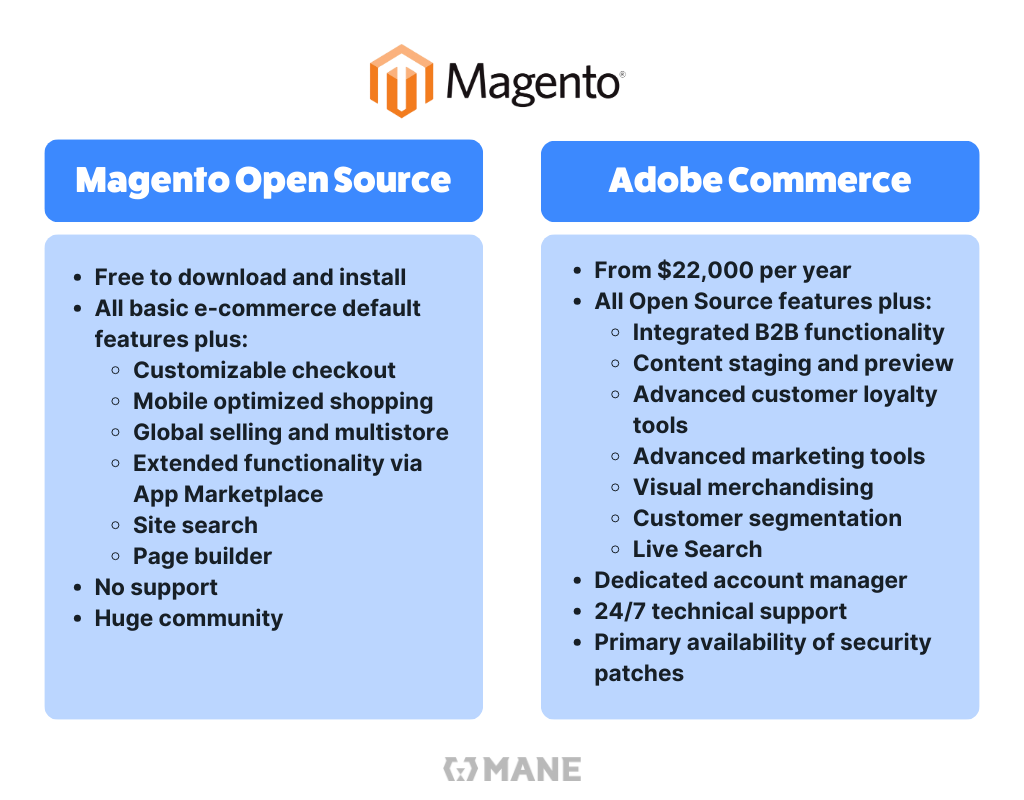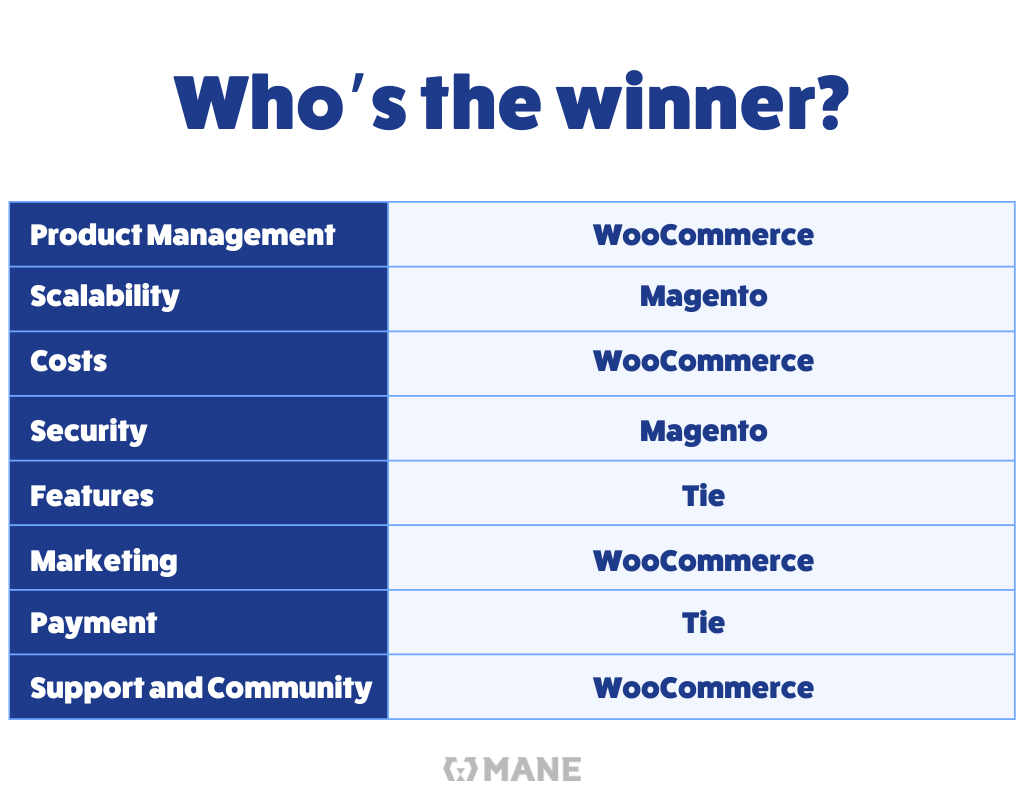
WooCommerce vs Magento – Which to Choose in 2024?
Do you need help deciding which platform to base your eCommerce site on? This article will compare WooCommerce vs Magento to help you decide which best suits your business needs.
But first things first:
What is WooCommerce?
With a market share of 39%, WooCommerce is one of the most popular eCommerce platforms. It is an open-source plugin built for the most popular CMS, WordPress, launched in 2011.
WooCommerce is easy to install and use. It has numerous themes, as you can use most of the WordPress themes for your eCommerce site when basing it on WooCommerce.
Finally, WooCommerce offers many themes and plugins, enabling you to integrate various features needed for your business goals seamlessly.
Pros of WooCommerce
The main advantages of using WooCommerce for your eCommerce business include:
- User-friendliness. WooCommerce is easy to use, even if you do not have web development experience.
- Well-documented. WooCommerce offers comprehensive documentation that will help you find answers to most of your questions related to setting up and maintaining your web store.
- Marketing. WooCommerce offers extensions to optimize your store’s SEO performance, such as Yoast and Google Analytics integration.
Cons of WooCommerce
The primary cons of using WooCommerce are:
- Even though it is easy to use if you have never used WordPress before, you will still need to learn how to use WordPress CMS and the WooCommerce plugin. Alternatively, consider relying on professional WordPress development services.
- Although WordPress and WooCommerce are free, some extensions and themes require additional payments.
What is Magento?
Magento, also known as Adobe Commerce, is a CMS (content management system) created as a comprehensive eCommerce platform.
Magento comes in two versions: Magento Open Source and Magento Commerce. Magento Commerce has premium packages, while Magento Open Source is free.
Magento is a platform that enables developers to build web shops. As such, it isn’t easy to use for beginners or intermediates in coding.
However, if your business has dedicated PHP developers or you are a web developer, Magento provides robust solutions that scale well regardless of your business’s size. 
Pros of Magento
The main benefits of using Magento include the following:
- Scalability. As it is geared toward medium and large businesses, Magento can handle large stores (provided your host can support large article quantities and user traffic).
- Customer-friendly. The checkout process is streamlined, enabling your customers to check out promptly.
- Payment gateway. Magento comes with PayPal, Braintree, and Authorize.Net.
Cons of Magento
The main cons of Magento include the following:
- Costs. Magento is usually a much more expensive solution as it focuses on medium- to large-scale businesses.
- Difficult to use. As we already mentioned, Magento is complex to use for businesses that do not have a dedicated web development team.
WooCommerce vs Magento – Detailed Comparison
This section will compare WooCommerce and Magento to help you decide which aligns best with your business needs.
We will compare the two eCommerce platforms through the most critical factors for establishing a successful online store.

Which platform has a better product management system?
An intuitive product management system is among your top priorities when setting up the best eCommerce website for your business.
WooCommerce offers an easy-to-use product management system that enables you to list both physical and digital products. If you are familiar with WordPress CMS, setting up new items will be effortless.
Magento, however, offers some of the features that WooCommerce does not support by default, including product personalization, product reviews, and grouped items. When using Magento, you will have those features without buying additional extensions.
However, we recommend using WooCommerce, especially if you are starting, due to its ease of use. You can buy product management add-ons later when your business needs them. If you choose that approach, you will save on buying features you might not need.
Winner: WooCommerce.
Which platform scales better?
Due to being targeted at medium and large-scale businesses, Magento has a slight advantage over WooCommerce. If you choose Magento, your eCommerce website is optimized to process thousands of orders.
However, it’s worth noting that this only applies to Magento Commerce (formerly known as Magento Enterprise), which comes at significantly higher costs than WooCommerce solutions.
Even though both eCommerce platforms will enable your business to offer unlimited products, when scalability is concerned, Magento has a slight upper hand.
Winner: Magento.
Which platform is more budget-friendly?
WooCommerce is open-source and free to use, while Magento offers a limited free-to-use open-source version. That means you can create a free eCommerce website using either of the platforms.
However, even though you can use both platforms for free, you will usually need additional add-ons to cover all your business needs. In that regard, WooCommerce is more budget-friendly.
If you choose WooCommerce, you will not need to change to a more robust and (far) more expensive version of the platform later. You will only need to add additional add-ons to satisfy your needs. With Magento, you will likely need to switch to the Commerce version as your business store grows.
Finally, basing your eCommerce website on WooCommerce will likely come with lower hosting costs as most hosts optimize their platforms for WordPress.
Winner: WooCommerce.
Which platform has better security systems?
Magento and WooCommerce have open-source code. While their open-source nature enables developers to create efficient solutions, it makes them more vulnerable.
Due to the critical importance of data security and the risks related to the open-source nature of both platforms, you must take preventive measures to ensure your customer data is safe regardless of the platform you choose.
Magento has fewer plugins, which means fewer security risks. Additionally, Magento offers security patches. However, having them can be challenging to implement. If you are not a professional developer, consider hiring cybersecurity experts to install security patches and ensure data security.
Regardless of your preference for WooCommerce or Magento, you will need to hire in-house developers or outsource to an agency that provides custom web development services to ensure optimal security.
Winner: Magento.

Which platform offers more features?
When it comes to functionalities, Magento offers more features by default.
Magento is capable of multiple stores, multi-language support, and in-depth product configuration out of the box.
On the other hand, WooCommerce does not have those features by default, but they are easy to install using add-ons.
When it comes to extensions, both WooCommerce and Magento offer a wide range of options to choose from. WooCommerce extensions are usually more budget-friendly, while Magento extensions are generally more robust.
Winner: Tie.
Which platform is better for marketing and SEO?
As WooCommerce is built on a foundation of WordPress initially intended for blogging, it includes various marketing and content optimization tools by default. It also offers SEO plugins such as Yoast SEO that will enable you to optimize your website for search engines effortlessly.
Both platforms offer easy-to-use Google Analytics plugins. However, Magento is far more limited when it comes to marketing tools.
Although Magento provides professional marketing tools, they are only available in the paid version. Using Magento SEO and other marketing tools is much more expensive than WooCommerce.
Winner: WooCommerce.
Which platform has better payment options?
Both platforms offer a good amount of payment gateways.
By default, WooCommerce supports bank transfers, PayPal, Stripe, checks, and cash options. You can quickly implement additional payment gateways using plugins. For example, you can use extensions to enable Google Pay, Amazon Pay, Alipay, and other popular payment methods.
On the other hand, Magento supports PayPal, Authorize.net, and Braintree by default. Additional gateways are also easily added by using add-ons.
As both platforms offer a variety of payment methods, there is no clear winner.
Winner: Tie.
Which platform has better support and community?
Although both platforms have large communities, WooCommerce wins in this regard.
Being a plugin for the most popular CMS, WordPress, on which 62% of all websites are based, WooCommerce has a large pool of developers and users. That means you will have a wealth of resources and community support when starting a WooCommerce store. If you choose WooCommerce, you can rely on the community to find solutions for most of the problems you might experience.
Conversely, Magento has a significantly smaller community, making finding a solution for a particular issue you might experience more challenging. However, when using the paid version, you will have additional support options like phone, email, and ticket systems.
Regardless of your chosen platform, consider hiring developers for maintenance and support or outsourcing maintenance to a significantly lower cost agency.
Winner: WooCommerce.

WooCommerce vs Magento – Which to Use?
Choosing between WooCommerce and Magento is by no means an easy task. Both platforms come with their distinct advantages. While WooCommerce is far easier to configure and use, Magento provides more robust solutions intended for large companies.
When performance and scalability are concerned, Magento has a slight advantage by being intended for running large store sites. However, performance is mainly dependent on your hosting provider. As such, there should be more than a slight performance advantage for using Magento instead of WooCommerce.
We recommend using WooCommerce in most cases. If you are starting an eCommerce store or running a small to medium-sized business, WooCommerce is an excellent choice. By choosing adequate add-ons, you will have all the benefits of Magento while having a store that is easier to use and more budget-friendly.
On the other hand, Magento is worth considering if you are running a large-scale online business, as its Commerce version caters to the needs of large companies.
In all other cases, however, we advise you to use WooCommerce.
If you are still trying to decide whether to use WooCommerce or Magento or have any questions we still need to cover, book free consultations on our website or email at hello@manedigital.co, and we will do our best to help you.
FAQ
1. How long does it take to develop and launch an eCommerce website?
The time needed for developing a new web store depends on the platform you choose and the complexity of the features you need.
For example, if you decide to base your store on WordPress and use a WooCommerce plugin, and you do not need any custom features, your store could be up and running within a few weeks.
On the other hand, if you need many features or have thousands of products, development might take months.
If you wish to get an estimated timeframe, book free consultations at MANE Digital, and we will do our best to help you.
2. How much does it cost to develop an eCommerce website?
The cost of developing an online store depends on the complexity of your eCommerce website, the platform you choose, the number of products you wish to list, and the features you need.
As the budget depends on various factors, giving a general estimation of the costs is impossible.
That’s why we provide free consultations at MANE Digital. Send us an email at hello@manedigital.co, or contact us through our website, and we will do our best to give you a quote promptly.
3. How much does Magento Enterprise cost?
The basic version is free to use. Magento Commerce starts at $1988 per month, while Magento Commerce Cloud begins at $2800 monthly.



